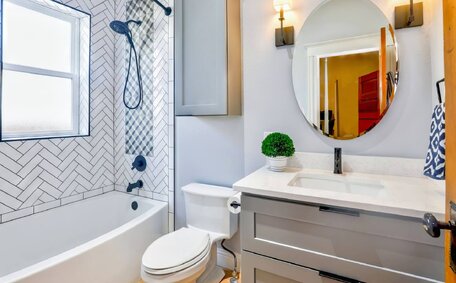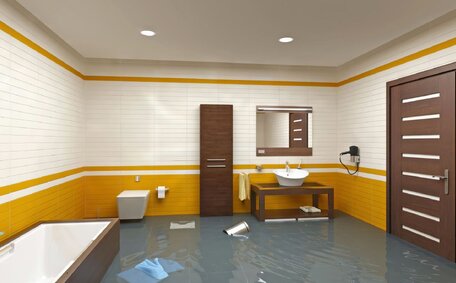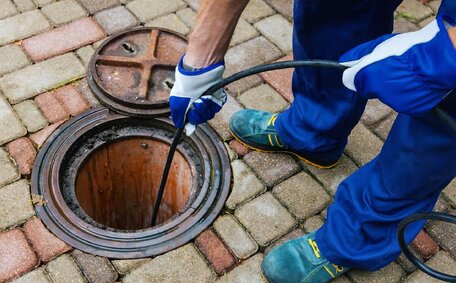Being prepared by understanding how to shut off your water and having a trusted plumber’s contact details can significantly reduce risk and damage.
Fast action to shut off the main water valve is key to protecting your property and family in the event of a plumbing disaster. Common plumbing emergencies can ambush any homeowner, and if unaddressed, can lead to serious water damage, electrical hazards, and hefty repair bills.
Cherrybrook Plumbing has been assisting Sydney residents with expert plumbing services for over 15 years.
Whether it’s a burst pipe flooding your home or a blocked drain causing a sewer line backup, our experienced team can quickly respond to any plumbing catastrophe. We serve residential and commercial customers throughout Cherrybrook and understand how stressful and financially devastating plumbing emergencies can be if not handled immediately.
This guide details critical actions homeowners should take to protect their property by turning off the main water in the face of a plumbing emergency. Having an action plan ready means you won’t panic when disaster strikes, allowing you to shut off main water swiftly, minimising potential damage during plumbing mishaps. We’ll provide guidance on promptly turning off the main water valve and tackling plumbing issues before they worsen.
Locate and Turn Off the Main Water Supply
The crucial first step during a plumbing crisis is to shut off the water supply to your home. Locate the main water shutoff valve, typically near the front of your house or garage, or adjacent to your water meter.
This action prevents additional water from compromising your hot water system and signals it’s time to contact the plumber for your plumbing needs.
The valve, often resembling a spigot or tap handle, should be turned clockwise until it stops.
Completing this procedure effectively halts the flow of water into your home’s plumbing system. Shutting off the main valve is an effective strategy to minimize damage and is essential before the plumber arrives.
If you cannot find the main valve or are unable to turn it off, try shutting off isolation valves under sinks and toilets, or individual valves on appliances like water heaters.
Additionally, switch off the power to your water heater to mitigate risks like electrocution or electrical shocks.
Photograph the situation extensively to provide your plumber with a detailed overview and ensure you call the plumber immediately for prompt assistance. With the water shut off, your home is protected from further damage while you await assistance.
Our team at the plumbing company always underscores the significance of making sure you know where your main water valve is situated for a quick shut-off when required.
Contain any Leaks or Flooding
Once you’ve shut off the main water supply, it’s the right time to call a local plumber to contain any active leaks or flooding in your home. Having towels, rags, buckets and other absorbent materials on hand can save a lot of hassle by helping to soak up excess water.
Stay prepared to swiftly apply pressure to leaks with towels or rags. Mop up any standing water on the floors. Use heavy-duty paper towels or a wet/dry vacuum to efficiently soak up excess water.
For more severe flooding, judicious use of large buckets or even plastic storage bins to catch water escaping from a compromised pipe can mitigate damage. Place them under leaking pipes or in any areas with significant pooled water.Move your belongings or valuables away from the affected zone before you undertake plumbing repairs to shield them from potential damage.
While preparing to call emergency plumber services, remain vigilant near leaks, mopping up further ingress of water where necessary. The goal is to keep the water damage contained to as small of an area as possible.
Refrain from any DIY repairs that might exacerbate the issue. Your focus should be on stopping the flow of water and controlling the flooding until a licenced plumber can completely repair the issue.
Protect Belongings from Water Damage
Once the main water supply is turned off, it’s crucial to consider what can be done to protect your valuables and possessions from water damage. Quickly move furniture, rugs, electronics and other belongings to dry areas if possible. Use tarps or plastic sheeting to cover larger items that can’t be moved.
For smaller items, place them on counters, tables or elevated surfaces to get them off wet flooring. Keep your belongings dry by making sure to wipe down wood furniture and dry any wet surfaces. Remove and elevate any items stored on basement floors or lower levels where flooding can occur.
Act quickly to remove your belongings from the path of potential water damage. Water can quickly seep into carpets, wood and fabrics, so every minute counts. Being proactive not only safeguards your property but also helps you avoid the scenario where you end up with costly repairs in the future.
We understand the disruption caused by plumbing emergencies and provide effective guidance for management. We’re here to enlighten you on what to do while awaiting your emergency plumber, providing practical tips to curtail damage.
The goal is tong Harmful Chemicals
During a plumbing emergency, avoid using chemical drain cleaners or other harsh products in an attempt to fix the issue hastily. However, it’s crucial to steer clear of these products as, instead of providing a quick-fix solution, they can actually worsen issues and cause serious pipe corrosion or damages.
Instead, cut off water supply to help minimize flooding and wait for help from a professional emergency plumber. Your focus should be on minimising immediate damage, not experimenting with makeshift repairs.
Here at Cherrybrook Plumbing, we care about our customers’ safety and the integrity of their water systems, including the proper use of off water valves. We’ll respond quickly in any emergency and rectify issues with advanced techniques to get your property back to normal.
Clear any Blockages
Possessing a plunger is a straightforward method to administer initial unclogging, which can help damage your home by preventing overflow before summoning a plumber. Position the plunger over the drain and use rapid up-and-down motions to dislodge debris; for slow drains, a drain snake or auger can be used to extract hair, soap scum, or other obstructions.
Carefully crank to remove blockages, slowly extracting blockage material. Avoid over-cranking or applying too much force, which could damage your pipes.
Document the Situation
Essential actions include calling your plumber and documenting your plumbing emergency with photos. Take clear, well-lit photos of the affected areas from multiple angles before they arrive.
Capture images of actively leaking pipes, significant water damage, flooding, and any other relevant issues in the affected area before they arrive. This documentation supports insurance claims and informs the plumber about the extent of the issue.
Sensible documentation will aid your case but remember to keep a safe distance from any danger, including natural gas leaks.
Do not touch live electrical appliances that have come into contact with water. If an area is hazardous, wait until the premises can be secured before approaching.
photos, take notes about the timeline of events and the location of leaks or damage. Providing this information to your emergency plumber upon their arrival will illustrate the extent of the problem to insurance adjusters and expedite your claim.
Photograph Damage for Insurance
What do plumbing professionals suggest? It’s crucial to meticulously capture any property damage that transpires during a plumbing emergency. Take clear, well-lit photographs of all affected areas from multiple angles. Take general shots to show the overall impact and detailed pictures of leaks, flooded areas, or soaked items.
Photograph any ceiling water stains, buckling walls or floors, flooded basements, and any other damage a plumbing issue might have caused to your house’s structure. Date and time-stamp the images to establish a timeline. Avoid electrical hazards but get photos of appliances that have been in contact with water.
Detailed photographic evidence is vital for filing insurance claims after the plumbing emergency has been resolved. The images substantiate the damage to get your claim processed faster. Providing thorough documentation also helps demonstrate the urgency of the issues when the plumber arrives.
Our team recommends proactive measures to address potential issues, significantly reducing the stress of future plumbing emergencies. Let us handle getting your property back in order so you can focus on getting the right documentation for your insurance company.
Contact a Licensed Plumber
At Cherrybrook Plumbing, our team of experts is available 24/7 to provide prompt plumbing service during your next crisis.
Contact our responsive plumbing team at 1300 349 338 or via email at [email protected]. Provide details on the type of plumbing emergency, such as a burst pipe, gas leak, or sewer line backup. Let the dispatcher know if there is active water damage or flooding so we can send out a crew immediately.
A licenced professional has the skills and equipment to fully repair burst pipes, clear blockages, replace fixtures, and restore your plumbing system to normal operation. Attempting DIY repairs without assistance can go badly; turning off your water supply can worsen issues and put your safety at risk.
Our Cherrybrook plumbers are at your service; they’re local, licenced, and fully insured. We understand the stress a plumbing emergency can cause and will work quickly and efficiently to minimise disruption and restore your home’s plumbing.
Don’t wait with water actively leaking - contact us right away so we can prevent further damage. Our friendly staff is standing by to take your call and despatch an emergency plumber to your property as soon as possible.
DIY attempts might worsen the problem and enhance electrocution risks; thus, professional service is crucial. Disconnect power to any appliances exposed to water. Document new leaks or damage that occur while waiting. If you smell gas, evacuate immedia>
Proactively maintaining your plumbing system, including the proper function of shutoff valves, is key to preventing emergencies. Install water sensors in problem areas to detect leaks quickly.
Schedule Regular Plumbing Inspections
Annual inspections by a professional can detect and address any plumbing issues before they worsen.
During an inspection, the plumber can help check for leaks, corrosion, clogs, and other problems. They can test water pressure, drain flow, and pipe integrity. If any repairs are needed, they can be addressed promptly before causing a larger failure.
Being forward-thinking can pave the way towards ensuring you limit potential repair costs. Addressing minor plumbing issues promptly prevents expensive emergency damage repairs. Regular maintenance also extends the lifespan of your system, which is why we highly recommend it.
At Cherrybrook Plumbing, our licenced technicians provide true plumbing expertise through comprehensive inspection services for residential and commercial systems. We use state-of-the-art diagnostics to assess your plumbing health and make expert recommendations.
Don’t wait for a plumbing catastrophe to strike. Schedule yearly inspections with our team to identify and address issues early. Preventative maintenance is the key to avoiding costly and chaotic plumbing emergencies in your home or business.
Install Leak Detection Devices
Installing leak detection devices is an excellent preventative measure to avoid plumbing emergencies. These systems use sensors to identify excess moisture, leaks, or flooding issues and immediately shut off your home’s water supply to prevent catastrophic damage.
There are wireless sensors you can place near appliances, under sinks, around toilets, and at other plumbing fixtures prone to leaks. The sensors connect to a central unit that sounds an alarm and automatically triggers the water shutoff valves near your toilet and main water line when a leak is detected.
Advanced leak detection systems, which monitor your entire plumbing network with wireless sensors, offer broader protection. These systems can pinpoint the exact location of leaks for a faster response for your unit. Some even integrate wimbing disaster preparedness. At Cherrybrook Plumbing, we’re happy to advise on the best leak detection options to secure your plumbing system against leak emergencies.
Installing leak detection devices near appliances, under sinks, and around toilets is an excellent strategy to prevent plumbing disasters. The sensors connect to a main control unit that sounds an alarm and triggers automatic water shutoff valves installed on the home’s main waters. Some even integrate with smart home platforms to send alerts to your phone when a leak is found.






